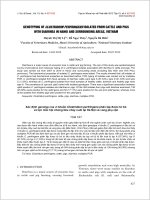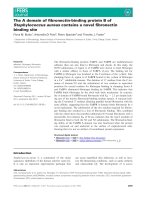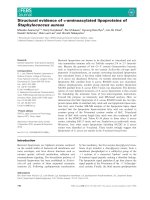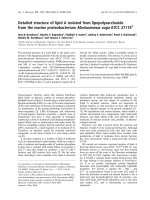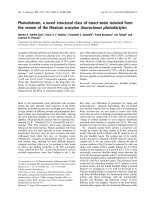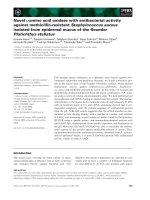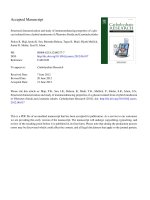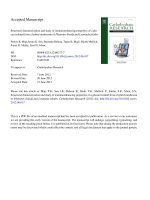Capsular typing of staphylococcus aureus isolated from raw milk samples using duplex polymerase chain reaction
Bạn đang xem bản rút gọn của tài liệu. Xem và tải ngay bản đầy đủ của tài liệu tại đây (218.47 KB, 7 trang )
Int.J.Curr.Microbiol.App.Sci (2020) 9(11): 2044-2050
International Journal of Current Microbiology and Applied Sciences
ISSN: 2319-7706 Volume 9 Number 11 (2020)
Journal homepage:
Original Research Article
/>
Capsular Typing of Staphylococcus aureus Isolated from Raw Milk Samples
using Duplex Polymerase Chain Reaction
A. Khan1*, R. Sharma1, R. Grover1 and M. Rizwan2
1
Department of Biotechnology, Mahatma Jyoti Rao Phoole University,
Jaipur, Rajasthan, India
2
Multi-Disciplinary Research Unit, S.P. Medical College, Bikaner, Rajasthan, India
*Corresponding author
ABSTRACT
Keywords
Staphylococcus
aureus, Milk, cap5,
cap8
Article Info
Accepted:
15 October 2020
Available Online:
10 November 2020
The present investigation was designed to determine the frequency of capsular
polysaccharide genes (cap5 & cap8) in Staphylococcus aureus strains isolated from raw
milk samples of various regions of Jaipur, the capital city of Rajasthan state of India. In
this study presence of S. aureus and cap5and cap8 gene was evaluated by Polymerase
Chain Reaction. A sum of 59 strains of S. aureus (confirmed by 23S rRNA amplification)
were selected and screened for the presence of capsular genes. PCR amplification of the
gene segment encoding cap5 and cap8 gene yielded product size of 361 and 173 bp,
respectively. In the present study total 54.24% strains were found to carry cap5 gene
whereascap8 gene was found with 27.12% prevalence. Presence of both genes was found
is 10.17% strains. Maximum prevalence (66.76%) of cap5 gene was present in the strains
of Amer and Bagru regions while lowest prevalence (37.50%) was found in the strains of
Durgapuraregion of Jaipur city. Further, prevalence of cap8 gene was maximum (42.86%)
found in strains of Sodala area which is surprisingly as similar as cap5 gene and was
lowest in strains of Amer area (11.11%). 25% of the strains of Durgapura area were not
typable. This study revealed that presence of cap5 gene was higher than cap8 gene and
also provides an idea that infection of S. aureus may pose a potential risk to human health
and these result may support the future strategies and actions related to milk safety
programs.
Introduction
Milk is a great medium for the growth of
many
microorganisms
and
microbial
contamination in milk can be largely happen
from three fundamental sources viz. inside the
udder, outside of the udder and through the
surface of milk dealing equipments. The
prevalent unhygienic conditions, poor
commercialization of dairy sector and
improper handling practices favors the
entrance of these undesirable and infectious
microorganisms into milk and affects the
overall nutritional and market value of the
product. As evidence from previous
investigations, presence of such pathogenic
bacteria poses serious health hazards to
human and animal’s health (Soomro et al.,
2003).
2044
Int.J.Curr.Microbiol.App.Sci (2020) 9(11): 2044-2050
Staphylococcus aureus is an essential
pathogen of nosocominal contaminations and
it is liable for wide scope of human illnesses
including skin disease, bone infection, food
contamination, endocarditic, toxic shock
syndrome etc. Remembering bovine mastitis
for domesticated animals S. aureus is likewise
the third most revealed reason for food borne
diseases on the earth (Normanno et al., 2005).
Different PCR based identification techniques
were produced for S. aureus identification but
most of them were not found satisfactorily or
trustworthy to distinguish total strains of
Staphylococcus aureus. Afterward, Straub et
al.(1999) built up a Polymerase Chain
Reaction (PCR) framework which depended
on single primer pair focused against 23S
rRNA based species targeted primer,
permitting targeted identification of total
strains of species. The aimed sequence 23S
rRNA was picked on the grounds that it
satisfied the necessity of phylogenetic marker
having most reliability. This technique is
presently being utilized broadly by numerous
researchers all through the world for
genotypic identification and authorization of
Staphylococcus aureus among different type
of contaminations (Khichar et al., 2014).
Capsular polysaccharide enhances the
bacterial virulence by rendering the bacteria
resistant to phagocytosis. Although 11
capsular polysaccharide serotypes have been
recognized in Staphylococcus aureus isolates,
only types 5 and 8 are common in
Staphylococcus aureus isolated from human
and bovine infections.
The majority of Staphylococcus aureus strains
isolated from bovine mastitis is encapsulated
and the distribution of capsular serotypes
among Staphylococcus aureus isolates from
bovine mastitis from different countries
shows great variability. Hence this study was
designed to characterize cap5 and cap8 genes
in S. aureus isolates from raw milk samples of
different regions of Jaipur city of Rajasthan,
India.
Materials and Methods
The current investigation was attempted to
determine
the
predominance
of
Staphylococcus aureus as a developing food
borne microbe considering its general
wellbeing essentialness with the point of
isolating and recognizing S. aureus from raw
milk samples. The recouped isolates were
confirmed based on their biochemical,
morphological and cultural characteristics and
further by Polymerase Chain Reaction (PCR)
at species and genus level. Cultures identified
as S. aureus were exposed to study for their
properties corresponding to in vitro
characterization for the presence of capsular
polysaccharide (cap5 & cap8) genes.
Isolation of S. aureus from milk samples
A sum of 790 raw milk samples were
collected from 8 different regions of Jaipur
city of Rajasthan, India. The samples were
taken from street wanders and clinically
healthy animals in sterile bottles. Initially
samples were identified by conventional
microbiological methods using phenotypic
and biochemical characteristic. In this regard,
the samples were poured onto Staphylococcus
aureus specific chromogenic agar plates
which contain polymyxin B (50 units/ml)
(HiMedia Laboratories, India). After 24 hours
of incubation at 37ºC, the colonies which
produce greenish and bluish colour were
transferred to a BHI broth medium. The color
mixture in the center is specifically engraved
by Staphylococcus aureus to produce bluishgreenish colonies, which can be seen clearly
against a dark background. For the further
confirmation the cultures were suspended on
Baird Parker Agar and Mannitol Salt Agar
Plates (Himedia Laboratories). Subsequently,
2045
Int.J.Curr.Microbiol.App.Sci (2020) 9(11): 2044-2050
colonies were examined for morphology after
Gram staining and confirmed using the API
staph kit group (bioMeriux, Marcy-l’Etoile,
France). By tube plasma agglutination test
clustered colonies confirmed for coagulation
activity were tested.
Genotypic confirmation
(Ribotyping)
of
S.
aureus
The microbiologically confirmed cultures
were allowed to grown overnight in incubator
shaker in BHI broth and then DNA was
isolated from these cultures individually by
the method of Pospiech and Neumann (1995).
DNA
quantification
was
done
by
spectrophotometer (Sambrook et al., 1989)
and then DNA was diluted to concentration of
25 ng/μl in TE buffer and ribotyping based on
23S rRNA gene was done (Straub et al 1999)
using species specific primers i.e. (Primer-1)
5’-CGGAGTTACAAAGGACGAC-3’and
(Primer-2)
5’-AGCTCAGCCTTAACGAG
TAC-3’. A 25 µl PCR cocktail was prepared
which is composed of 12.5µl of 2X
DreamTaq green PCR master mix (Thermo
scientific, Mumbai, India), 0.5 µM of each
primer and 1µl of template DNA was
prepared and performed in a thermocycler
system (Agilent Technologies, New Delhi,
India). The programme used for PCR cycles
was: 2 min at 95ºC, followed by 35 cycles of
30s at 95ºC, 45s at 57ºC and 60s at 72ºC with
a final extension of 10 min at 72ºC. 1 kb
ladder (Thermo scientific, Mumbai, India)
was used as marker on 1.2% agarose gel.
Amplification of cap5 and cap8 genes
For the amplification of cap5 and cap8 genes
the method of Verdier et al., (2007) was
followed. The primers sequence were
(Primer-1) 5’-GTCAAAGATTATGTGATG
CTACTGAG-3’ and (Primer-2) 5’-ACTTCG
AATATAAACTTGAATCAATGTTATACA
G-3’used for the amplification of cap5 gene
and it were (Primer-1) 5’-GCCTTATGT
TAGGTGATAAACC-3’ and (Primer-2)5’GGAAAAACACTATCATAGC
AGG-3’
used for the amplification of cap8 gene. A 25
µl PCR cocktail was prepared as per quantity
mention above. The programme used for
cap5&cap8gene PCR cycles was: 2 min at
95ºC, followed by 35 cycles of 30s at 94ºC
(denaturation), 50s at 55ºC (annealing) and
50s at 72ºC (elongation) with a final
extension of 10 min at 72ºC. The PCR
products, after addition of 2 μl of trekking dye
were resolved in 1.2 % agarose gels prepared
in 0.5 x TBE buffer containing 0.5 μg/ml of
ethidium bromide. 100 bp DNA ladder
(Thermo scientific, Mumbai, India) was used
as marker. The amplified products were
electrophoresed for 2 hours at 100 V. After
that the gel was visualized under Gel
Documentation system (Bio-Rad, USA).
Results and Discussion
Here at initial level, S. aureus isolates were
identified by conventional microbiological
procedures using biochemical and phenotypic
characteristics and then final confirmation
was done by 23S rRNA based ribotyping
developed by Straub et al., (1999) for
genotypic confirmation. The PCR products
having amplicon size of 1250bpwere
confirmed as S. aureus. In the present
investigation, out of 790 milk samples
isolated from different regions of Jaipur city,
only 144 isolates were confirmed on
molecular level. Out of these 144 confirmed
samples 59 isolates shows positivity towards
coagulase producing gene (coa gene) and
these samples having coa gene were selected
for this study (Data related to coa gene is not
mentioned here). The same method of
genotypic confirmation has been used by
Yang et al., (2012); Parth et al., (2016);
Hamid et al., (2017) and Choudhary et al.,
(2018). They obtained species-specific
amplicon of 1250 bp which confirm
2046
Int.J.Curr.Microbiol.App.Sci (2020) 9(11): 2044-2050
genotypic identification of this organism.
They did the same from milk samples of
different geographical locations.
Genes for antiphagocytosis (cap5 and cap8)
The PCR products 361 bp and 173 bp confirm
the presence of cap5 and cap8 gene,
respectively. A duplex PCR was carried out to
detect both cap5 and cap8 (capsular genes) in
single PCR reaction and also to detect
variability in capsular genes (cap5 and cap8)
among 59 S. aureus isolates. Out of 59
strains, 32 isolates (54.24%) produced
amplicon size of 361 bp confirming the
presence of cap5 gene and 16 isolates
(27.12%) expressed presence of cap8 gene
with173 bp amplicon size (Table 1). Thus, the
majority of the analyzed isolates were
havingcap5genes with compared to cap8
gene. Both genes were detected in 06 isolates
(10.17%). Variability in prevalence of
capsular genes was observed in S. aureus
isolates with respect to different places of
sampling though cap5 genotype predominated
almost in all the regions except Sodala region
as displayed in the form of figure (Fig. 1 and
2).
Table.1 Distribution of the cap5 and cap8 genes among S. aureus isolates obtained from
different regions of Jaipur city
S. No. Place of
No. of
Total prevalence of capsular polysaccharides gene %
sampling
samples cap5 (361bp) cap8 (173bp)
Both
NT
9
6 (66.67%)
1 (11.11%)
2 (22.22%)
0 (0.00%)
1. Amer
6
4 (66.67%)
2 (33.33%)
0 (0.00%)
0 (0.00%)
2. Bagru
8
3 (37.50%)
2 (25.00%)
1 (12.50%)
2 (25.00%)
3. Durgapura
5
3 (60.00%)
2 (40.00%)
0 (0.00%)
0 (0.00%)
4. Jhotwara
8
4 (50.00%)
2 (25.00%)
1 (12.50%)
1 (12.50%)
5. Khatipura
Mansarovar
10
6
(60.00%)
3
(30.00%)
0
(0.00%)
1 (10.00%)
6.
6
3 (50.00%)
1 (16.67%)
2 (33.33%)
0 (0.00%)
7. Sanganer
7
3 (42.86%)
3 (42.86%)
0 (0.00%)
1 (14.29%)
8. Sodala
Total
59
32 (54.24%) 16 (27.12%)
6 (10.17%)
5 (8.47%)
*Abbreviations:- n= number of isolates; NT= non typable (negative for both cap5 and
cap8genes)
Fig.1 Distribution of cap5&cap8 gene (%) in Staphylococcus aureus strains isolated from milk
samples of various regions
2047
Int.J.Curr.Microbiol.App.Sci (2020) 9(11): 2044-2050
Fig.2 Agarose gel electrophoresis of thecap5&cap8 genes present in various strains of
Staphylococcus aureus. M=Marker (100 bp ladder)
The present study support the previous studies
reporting higher prevalence of cap5 gene (in
comparison to cap8 gene) in S. aureus
isolates from different sources viz. 60% cap5
gene by Upadhyay et al., (2010).Similarly
higher proportion of cap5 isolates has also
been published from Indonesia by Salasia et
al., (2004), Reinoso et al., (2008); Camussone
et al., (2012) from Argentina; Salimena et al.,
(2016) from Brazil, Kumar et al., (2011) and
Krithiga et al., (2018) from India. In a similar
study observed by Reinoso et al., (2008), the
higher percentage of cap5 genotype in human
isolates (11out of 45) than bovine strains (09
out of 45). All bovine strains were negative
with cap8 gene which is in dissimilar to
present study.
Maximum prevalence (66.76%) of cap5 gene
was present in the stains of Amer and Bagru
regions while lowest prevalence (37.50%)
was found in the strains of Durgapura region
of Jaipur city. Further, prevalence of cap8
gene was maximum found (42.86%) in the
strains of Sodala area which is surprisingly as
similar as cap5 gene and it was lowest in the
strains of Amer area (11.11%). 25% of the
strains of Durgapura area were not typable.
Actually such kinds of studies was not done
previously in these particular regions so here
we can only analyze the same data in
cumulative manner with others studies.
In contrary to present study, Tollersrud et al.,
(2000) reported a greater variation in the
distribution of capsular serotypes among
isolates from cows of various geographical
regions and reported a higher proportion of
cap8 than cap5 gene. Salasia et al., (2004)
observed that majority of the strains (12 out
of 19) isolated in Hesse, Germany harboured
the gene cap8 while Ikawaty et al., (2010)
detected cap8 in 73 isolates and cap5 in three
isolates from Netherlands. Some workers
didn’t record any of the isolates
harbouringcap8 gene (Proietti et al., 2010) or
carrying cap5 gene (Soares et al., 2017). Nontypable strains as observed in this study were
also reported by Upadhyay et al., (2010);
Yadav et al., (2015) from the same laboratory
and locations. Contrary to the above findings
very low (14%) percentage of cap5 and
cap8S. aureus isolates were detected by
Sordelli et al., (2000) as 7.10% serotype 5 and
6.60% serotype 8 and very high percentage
(86.20%) of non-typable isolates by
serotyping.
In conclusion the overall, outcome of this
study revealed that bovine raw milk samples
collected from the various regions of Jaipur
city of Rajasthan were contaminated with S.
aureus. By PCR based method, all the isolates
were typed by targeting specific genes
(cap5&cap8) with the predominance of
2048
Int.J.Curr.Microbiol.App.Sci (2020) 9(11): 2044-2050
cap5gene.This study will be helpful to obtain
a better knowledge on the distribution of
capsular
polysaccharides
among
Staphylococcus aureus present in milk
samples of various regions of Jaipur, the
capital of Rajasthan and might be helpful to
formulate future strategies to control the
bacterial contamination in milk.
References
Camussone, C., Rejf, P., Pujato, N., Schwab, A.,
Marcipar, I. and Calvinho, L. F. 2012.
Genotypic and phenotypic detection of
capsular polysaccharides in Staphylococcus
aureus isolated from bovine intramammary
infections in Argentina. Brazilian Journal
of Microbiology. 43:1010–1014.
Choudhary, S., Diwakar, Bhati, T. and Kataria, A.
K. 2018. Molecular typing of virulence
associated gene (spa) of S. aureus isolated
from cattle clinical mastitis. Journal of
Entomology and
Hamid, S., Bhat, M.A., Mir I. A., Taku A.,
Badroo G.A., Nazki S., and Malik A. 2017.
Phenotypic and genotypic characterization
of methicillin-resistant Staphylococcus
aureus from bovine mastitis, Veterinary
World, 10(3): 363-367.
Ikawaty, R., Brouwer, E.C., Duijkeren, V.E,
Mevius, D., Verhoef, J. and Fluet, A.C.
2010. Virulence factors of genotyped
bovine mastitis Staphylococcus aureus
isolates in the Netherlands. International
Journal of Dairy Science.5 (2): 60-70.
Khichar, V. and Kataria A. K. 2014. Capsular
genotyping (cap5k and cap8k) of
Staphylococcus aureus isolates from cattle
with clinical mastitis. Human and
Veterinary Medicine International Journal
of Bioflux Society. 6 (1): 30 -33.
Krithiga, N., Antony, P. X., Tollersrud, T.,
Mukhopadhyay, H. K., Pillai, R. M.,
Vijayalakshmi, P. and Thanislass, J. 2018.
Molecular
typing
of
capsular
polysaccharides of Staphylococcus aureus
isolated from cases of bovine mastitis by
PCR. Concepts of Dairy and Veterinary
Sciences.1(1)-.CDVS.MS.ID.000102.
Kumar, R., Yadav, B. R. and Singh, R. S. 2011.
Antibiotic resistance and pathogenicity
factors in Staphylococcus aureus isolated
from mastiticSahiwal cattle. Journal of
Bioscience. 36 (1):175–188.
Normanno, G., Firinu A., Virgilio S., Mula G.,
Dambrosio A., Poggiu A., Decastelli L.,
Mioni R., Scuota S., Bolzoni G., Di
Giannatale E., Salinetti A. P., La Salandra
G., Batoli M., Zuccon F., Pirino T., Sias S.,
Parisi A., Quaglia N. C., Celano G.V. 2005.
Coagulase-positive
staphylococci
and
Staphylococcus aureus in food products
marketed in Italy. Int J Food Microbiol
98:73-79.
Parth, F.M., Chauhan, H. C., Bhagat, A. G.,
Chandel, B. S., Patel, M. V., Dadawala, I.
and Kher, H. N. 2016. Detection of
virulence
associated
factors
from
Staphylococcus aureus isolated from
bovine mastitis. Buffalo Bulletin.35
(4):687-696.
Pospiech A, Neumann B: A versatile quick-prep
of genomic DNA from gram-positive
bacteria. Trends Genet 1995, 11(6):217218.
Proietti, P.C., Coppola, G., Bietta, A., Marenzoni,
M.L, Hyatt, D.R., Coletti, M. and
Passamonti, F. 2010.Characterization of
genes encoding virulence determinants and
toxins in Staphylococcus aureus from
bovine milk in Central Italy. Journal of
Veterinary Medical Science.72 (11):1443–
1448.
Reinoso, E. B., El-Sayed, A., Lämmler, C., Bogni,
C. and Zschöck, M. 2008. Genotyping of
Staphylococcus aureus isolated from
humans, bovine subclinical mastitis and
food samples in Argentina. Microbiological
Research.163 (3):314–322.
Salasia, S. I. O., Khusnan, Z., Lammler, C. and
Zschock, M. 2004. Comparative studies on
phenotypic and genotypic properties of
Staphylococcus aureus isolated from
bovine subclinical mastitis in central Java
in Indonesia and Hesse in Germany.
Journal of Veterinary Science. 5 (2):103–
109.
Salimena, A. P., Lange, C. C., Camussone, C.,
Signorini, M., Calvinho, L. F., Brito, M. A.,
Borges, C. A., Guimaróes, A. S., Ribeiro, J.
B., Mendonỗa, L. C. and Piccoli, R. H.
2049
Int.J.Curr.Microbiol.App.Sci (2020) 9(11): 2044-2050
2016. Genotypic and phenotypic detection
of capsular polysaccharide and biofilm
formation in Staphylococcus aureus
isolated from bovine milk collected from
Brazilian dairy farms. Veterinary Research
Communications. 40(3-4):97-106.
Sambrook, J., Fritsch, E.F. and Maniatis, T. 1989.
Purification of DNA.In: Molecular cloning:
A Laboratory Manual. 2ndedn.Cold-Spring
Harbor Laboratory, Cold-Spring Harbor,
New York.
Soares, B. S., Melo, D. A., Motta, C. C., Marques,
V. F., Barreto, N. B., Coelho, S. M. O.,
Coelho, I. S. and Souza, M. M. S. 2017.
Characterization of virulence and antibiotic
profile and agr typing of Staphylococcus
aureus from milk of subclinical mastitis
bovine in State of Rio de Janeiro. Arquivo
Brasileiro de Medicina Veterinária e
Zootecnia.69 (4):843-850.
Soomro, A.H., Arain, M.A., Khaskheli, M.,
Bhutto, B. Isolation of Staphylococcus
aureus from milk products sold at sweet
meat shops of Hyderabad. Online J. Biol.
Sci.,k 2003, 3(1): 91-94.
Sordelli, D. O., Buzzola, F. R., Gomez, M. I.,
Steele-Moore, L., Berg, D., Gentilini, E.,
Catalano, M., Reitz, A. J., Tollersrud, T.,
Denamiel, G., Jeric, P., Lee, J.C. 2000.
Capsule expression by bovine isolates of
Staphylococcus aureus from Argentina:
genetic and epidemiologic analyses.
Journal of Clinical Microbiology. 38(2):
846-50.
Straub, J. A., Hertel, C. and Hammes, W. P. 1999.
A 23S rRNA target polymerase chain
reaction based system for detection of
Staphylococcus aureus in meat starter
cultures and dairy products. Journal of
Food Protection.62 (10): 1150-1156.
Tollersrud, T., Kenny, K., Reitz, A. J. Jr. and Lee,
J. C. 2000. Genetic and serologic evaluation
of capsule production by bovine mammary
isolates of Staphylococcus aureus and other
Staphylococcus spp. from Europe and the
United States. Journal of Clinical
Microbiology.38 (8): 2998–3003.
Upadhyay, A., Kataria, A. K., Sharma, R. and
Singh, G. 2010 Capsular typing of
Staphylococcus aureus isolates from cattle
and goat mastitis by PCR targeting cap5K
and cap8K genes. Indian Journal of Animal
Science.80 (11):1062–1065.
Verdier, I., Durand, G., Bes, M., Taylor, K. L.,
Lina, G., Vandenesch, F., Fattom, A. and
Etienne, J. 2007. Identification of the
capsular
polysaccharides
in
in
Staphylococcus aureus clinical isolates by
PCR and agglutination tests. Journal of
Clinical Microbiology.45 (3):725-729.
Yadav, R., Sharma, S. K., Yadav, J., Nathawat, P.
and Kataria, A. K. 2015.Phenotypic and
genotypic
characterization
of
Staphylococcus aureus of mastitic milk
origin from cattle and buffalo for some
virulence properties. Journal of Pure and
Applied Microbiology. 9 (1): 425-431.
Yang, F. L., Li, X. S., Liang, X. W., Zhang, X. F.,
Qin, G. S. and Yang, B. Z. 2012. Detection
of
virulence-associated
genes
in
Staphylococcus aureus isolated from
bovine clinical mastitis milk samples in
Guangxi. Tropical Animal Health and
Production. 44 (8): 1821–1826.
How to cite this article:
Khan, A., R. Sharma, R. Grover and Rizwan, M. 2020. Capsular Typing of Staphylococcus
aureus Isolated from Raw Milk Samples using Duplex Polymerase Chain Reaction.
Int.J.Curr.Microbiol.App.Sci. 9(11): 2044-2050. doi: />
2050
